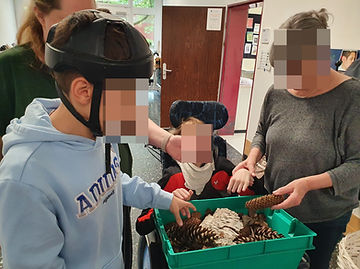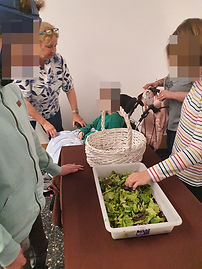
Table of contents for “The Forest”
Spring:
1. Fragrance oils with dandelion and spruce needle shoots
2. Ointments are made from the essential oils and dandelion honey is prepared
(1 and 2 belong together)
3. Pesto made from spruce needle shoots
4. Honey from dandelions is completed; an osmosis experiment;
Baked rolls and/or a delicious honey bread (2 and 4 belong together)
5. Spruce needle sugar is prepared
6. Pine needle vinegar is prepared and a pudding made from pine needle sugar
cooked (5 and 6 belong together)
7. Birch salt is produced and own butter is prepared for herb butter
8. Elderberry juice is prepared
9. Elderberry cheese is produced
10. Feast; birch salt rolls are baked
(7,8,9 and 10 belong together)
Summer:
Birch sap and hand wash
Birch sap and spruce needle candies
Spruce needle candies and spruce needle bath salts
Chive Pesto
The first three stories build on each other. The food is prepared in one hour, and processed in the following hours.
Autumn:
1. Bluebeet cake
3 . Chestnut detergent
4. Autumn picture
Basic experiential teaching in the subject Biology:
Bezugnehmend auf den Ausschnitt der Unterrichtsvorgaben NRW für das Aufgabengebiet „Naturwissenschaftlicher Unterricht“, Fach Biologie, ist es wichtig, dass die Schülerinnen und Schüler die Unterrichtsinhalte auf der basalen Ebene erleben.
Die Schülerinnen und Schüler nehmen die Natur mit ihren Pflanzen, Tieren und ihren Lebensräumen auf der basalen Wahrnehmungsebene wahr.
Die Protagonistin der Geschichten ist eine Puppe mit dem Namen Lotti. Für den basalen Erlebnisunterricht Erdkunde dient sie als Wiedererkennungsmerkmal. Sie führt die Schülerinnen und Schüler durch die einzelnen Geschichten.
Wie in der Einführung beschrieben, bestehen die einzelnen Geschichten aus Bausteinen oder sind eine Ideenbörse. Die einzelnen Blöcke können variabel eingesetzt werden, d.h., sie können je nach Zeit und Schülerschaft verändert werden.
Wichtig! Die Geschichten werden nicht abgelesen, sondern frei erzählt. Dabei kommt es nur darauf an, dass die Geschichte als Stimmungsrahmen dient.
Aufbau der Geschichten: Die Geschichten sind jeweils so aufgebaut, dass sie meistens mit einem Film (der jeweiligen Jahreszeit entsprechend) oder dem in der Geschichte beschrie-benen Wetter beginnen. Anschließend finden Wahrnehmungsangebote mit entsprechenden Materialien und die daraus resultierenden analogen Angebote statt. Am Schluss werden die Schülerinnen und Schüler wieder von ihrem Protagonisten verabschiedet.
Anmerkungen:die Rezepte können auch durch Verwendung anderer Pflanzen abgewandelt werden, je nach Geschmack oder was momentan wächst
in jeder Geschichte sind die kompletten Rezepte für die Vorbereitung und Fertigstellung eines Produktes vorhanden. Dieses ermöglicht, dass jeder für sich entscheiden kann, wie er die einzelnen Produkte herstellen möchte. Die meisten Produkte werden erst vorbereitet und müssen dann eine gewisse Zeit ruhen, sodass sich die Aromen ausbreiten können.
Bezugnehmend auf den Ausschnitt der Unterrichtsvorgaben NRW für das Aufgabengebiet „Naturwissenschaftlicher Unterricht“, Fach Biologie, ist es wichtig, dass die Schülerinnen und Schüler die Unterrichtsinhalte auf der basalen Ebene erleben. Siehe am Ende der Seite beschrieben.
Zu beachten sind die Richtlinien zur Sicherheit im Unterricht an allgemeinbildenden Schulen in Nordrhein-Westfalen (RISU-NRW) in ihrer jeweils aktuellen Fassung.
Impressions from the basic experience lessons in biology






Excerpts from the teaching guidelines for the goal-differentiated educational program Intellectual Development
"Biology lessons address topics from the students' immediate, lively world that are highly relevant to their self-determination and participation in society. The aspect of responsibility toward life and the environment, and the students' individual options for action in this regard, is addressed. The immediate and future relevance to the world is of particular importance. Access to the thematic content in biology is primarily achieved through subject-specific working methods and cognitive methods, which depend on the student's starting point in learning. When communicating about subject-specific content, a linguistically sensitive use of technical language is relevant, depending on the students' abilities. The content of biology offers various options for representing and presenting content and results, which can also be done digitally." (Page 11, *1)
Plants, animals and their habitats
Engaging with the content area "Plants, Animals, and Their Habitats" gives learners the opportunity to experience, better understand, and appreciate nature and their environment, and to take responsibility for it. Temporal sequences, rhythms, and processes of the living environment are perceived, and connections are experienced. Curiosity and interest in the living environment are awakened, and questions are explored through subject-specific working methods. Knowledge is acquired that sensitizes students to a responsible and respectful approach to their living environment and shows them possibilities for engaging with the topics covered. This can also open up opportunities for them to work in work or professional contexts. (*1, page 21)
Ecosystems, environmental and climate protection
Experiencing and recognizing relationships and interactions between plants, animals, and their habitats contributes to a fundamental understanding of nature. It demonstrates ways to adapt an individual's lifestyle to sustainable development in order to protect the environment and the climate. The impacts of human activities on ecosystems are experienced, and targeted measures for the conservation of nature are perceived, assessed, and implemented. A perception of biological diversity, combined with a positive attitude toward it, provides a basis for developing environmental awareness and a sense of responsibility toward the environment. (*1, page 22)
*1) Teaching guidelines for the goal-differentiated educational program Intellectual Development at all learning locations in North Rhine-Westphalia, subject area: Science teaching (Biology, Chemistry, Physics 2024)





